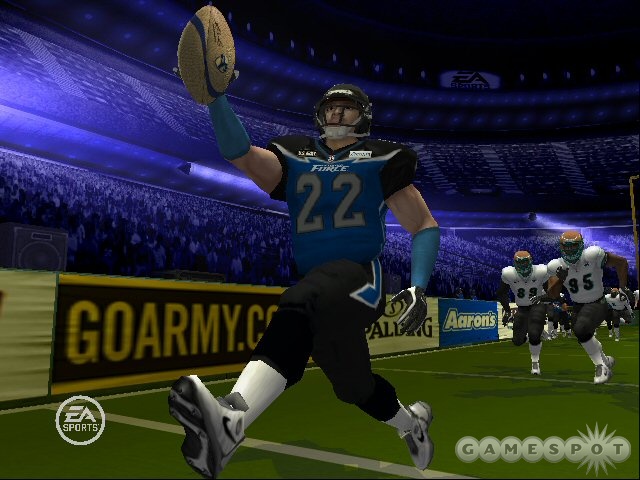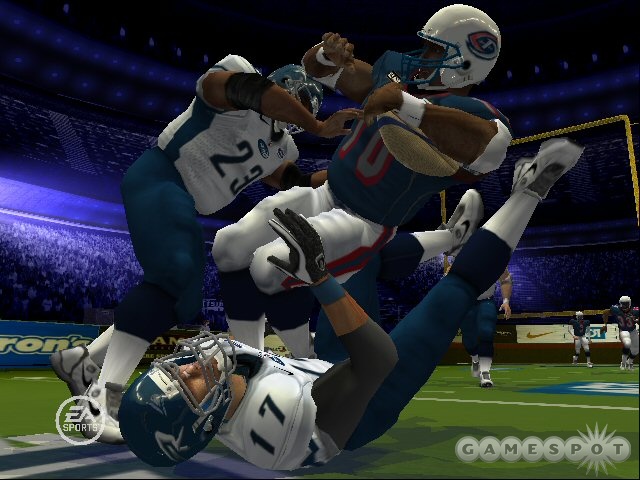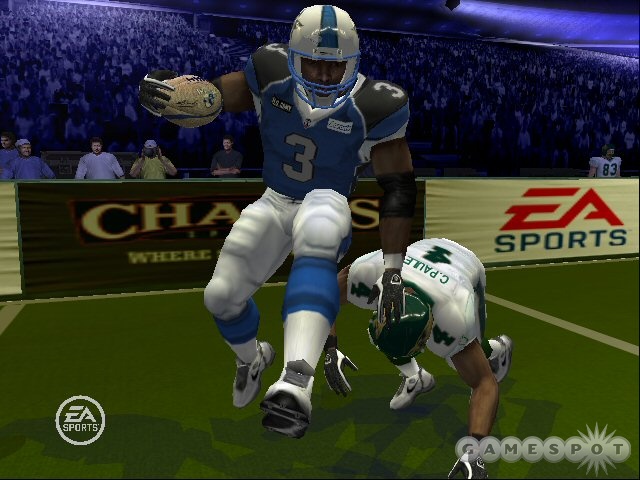EA Sports Arena Football Hands-On
We get our hands on EA Sports' upcoming game version of the fifty yard indoor war.
Few other sports would call a 45-40 final score a "defensive struggle." But then, few sports are like Arena Football--the 20-year-old indoor football league that has been steadily growing its fan base, thanks to a fan-first approach and an all-out offensive attack on the field of play. Our first look at Arena Football for PS2 and Xbox was back in June and we recently got hands-on time with EA Sports' first foray into the game version of the 50-yard indoor war that is Arena Football.

If you've never seen an AFL game on NBC, here's the short version of the sport: it's football stripped down to its core elements, with an eight-on-eight battle featuring athletes that play both sides of the ball; a 50-yard field that features padded walls instead of sidelines; a playbook that looks like something drawn up in your backyard when you were a kid; an abhorrence to the running game; and final scores that read more like college basketball games than traditional football. Translating that to a video game means focusing on making it streamlined and approachable enough for fans of arcade football (who are used to big scoring), while bringing in just the right amount of Madden-esque depth and strategy to keep hardcore football fans appeased.
When it came time to assign development resources to the game, EA Sports took an entirely fresh new team--the development house formerly known as Hypnotix (which EA purchased in July of this year). Formerly dedicated to over-the-top and raunchy Outlaw sports titles, the Hypnotix team has since been devoted to creating an authentic gaming experience from a sport that seems tailor-made to video games. The first job is acquainting folks with the sport and, thanks to a handy Arena Football 101 tutorial, as well as plenty of descriptive load screens that point out some of the finer points of the AFL, you'll have a pretty good idea of how to go about finding success on the field quickly.
It's the subtle differences that will stand out in the AFL game, after all. The sport's substitution rules are complex, as are the rules governing who can and can't blitz while playing on defense. There are two linebackers in the middle, but only one can blitz to the left or right of the center, and the other can't leave a specified rectangular area until the ball is thrown by the quarterback. This area is illuminated on the field to show you exactly how much room you have to work with, and if you move out of this box, you'll be penalized. So, it's common for that non-blitzing linebacker to act simply as a pass-blocker--and we found some success doing just that in our time with the game.

Passing is king in Arena Football, and that is reflected here as well. Team playbooks are heavily stacked in favor of the aerial game, and if there's not much variance in the playbook between teams, it's for good reason. While developing the game with AFL coach Jay Gruden (head man with the Orlando Predators), Gruden told the developers that the AFL teams use practically the same playbook anyway--the main difference between success and failure, then, has to be execution. The passing game plays a lot like Madden, which means that you can still lead passes with some touch on the right analog stick. There are some key differences, however. First of all, there's no passing cone, so you won't necessarily have an idea of where the quarterback is looking. And secondly, the increased game speed (producers told us the game is around 25 percent quicker than Madden) means you'll have a lot less time to get the ball off than you might think.
Another key difference is the ability to play as the wide receiver. Before the snap, you can choose to take control of any receiver and run routes as designed in the play, or take off in a completely different direction and run a route of your choosing. A cool tweak to this system is that, even when controlling the receiver, you can still have the quarterback throw to any receiver on the field, not just the one you control. Playing the receiver sounds like it might be a good decoy tactic, or at least it might help you get in some good screens for defensive backs, provided you run "creative" routes. Another key tactic when threatening close to the end zone is tossing the ball directly into the nets that are attached to the field-goal pylons and hoping your receiver comes up with the ball when it falls into the end zone--the AFL's own version of the Hail Mary pass.
On the defensive side of the ball, you have the same restrictions for linebackers and DBs mentioned above, but you also have one key weapon in your arsenal: the ability to late-hit players. It's not exactly an accepted part of the game in the real AFL, but in an attempt to make this game a more exciting and visceral experience, the developers have allowed some late hits after the whistle has blown. If anything, it's a great opportunity to show off some of the brutal new tackling animations that have made their way into the game. Sure, you'll probably be called for a penalty when pulling off this underhanded tactic, but the reward comes with the potential of injuring your victim in the process. Should you miss your late hit, however, and toss your head directly into the retaining wall, you run the additional risk of taking that player out with injury as well.

Because certain players on the field can be "iron men" (playing both offense and defense), player fatigue will play a huge role in Arena Football matches. When a player becomes fatigued, his performance will suffer on the field and the risk for injury increases. To help you keep track of each player's progression, there is a handy telemetry tool that you can access in the menu. Here you can see each player's fatigue level, as well as check on players' specific body parts for injuries. The telemetry data is color-coded: green for healthy, yellow for tired, and red…well, red is bad news. Telemetry is more than just data on the players, however. You can also use it to check up on team tactics. By checking out your opponent, for example, you can see which side of the field he prefers to throw to and which player he's most likely to hit when the game is on the line.
Because substitutions are so complicated in Arena Football, the development team is trying to find a balance between making substitutions easy and accessible, while at the same time preventing exploits that would take advantage of the rules, like loading up the field with speedy wide receivers and killing your opponent with raw speed. Another aspect that makes the Arena game feel different from other traditional football games is the idea that possession is sometimes more important than the score. If your ahead late in the game, it might work to your benefit to play soft, let your opponent score (which he's probably going to do anyway), and take your time killing the clock once you get the ball back. Sure, it's not an unheard of tactical move in the NFL, but it's far more prevalent in the AFL. Arena Football's kicking meter is new as well, featuring a pull-back and push-forward mechanic that's unlike any other EA football game currently on the market.

The look and feel of Arena Football, at least in terms of presentation, is more akin to Madden NFL 06 for the Xbox 360 (rather than on the PS2 and the Xbox). The reason for this is because the camera is closer to the action on the field and there is no traditional play-by-play commentary. Instead, you'll hear the players talk trash to one another. The arenas are all accurate to their real-life counterparts as well, all the way up to the individual JumboTrons, down to the differently shaped end zones that give some teams a slight advantage for deep corner passes.
With a franchise mode feature, online play, an authentic roster (complete with downloadable roster updates), and a host of unlockable Arena Football teams from the past (with such colorful names as the Portland Forest Dragons, Miami Hooters, and Minnesota Fighting Pike), Arena Football looks to be a full-featured game that is very authentic to the young and exciting sport it portrays. If the development team can manage to create that same excitement with compelling fast-paced gameplay, Arena Football will find a comfortable niche in the EA Sports pigskin pantheon. The game is due for release in early February, so stay tuned for more in the coming weeks.
Got a news tip or want to contact us directly? Email news@gamespot.com
Join the conversation